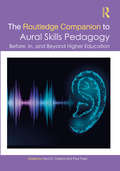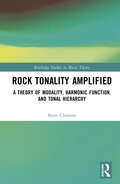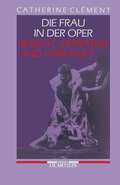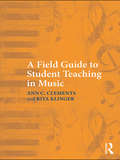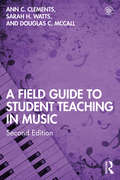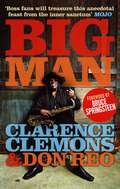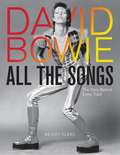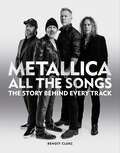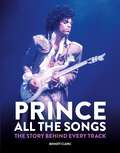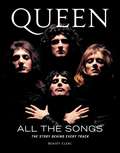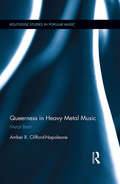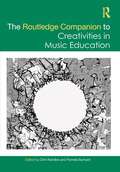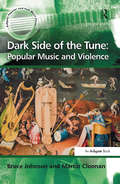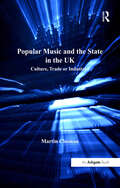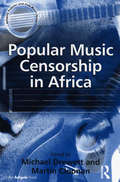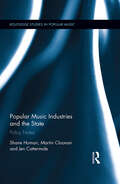- Table View
- List View
The Routledge Companion to Aural Skills Pedagogy: Before, In, and Beyond Higher Education (Routledge Music Companions)
by Kent D. Cleland Paul FleetThe Routledge Companion to Aural Skills Pedagogy offers a comprehensive survey of issues, practice, and current developments in the teaching of aural skills. The volume regards aural training as a lifelong skill that is engaged with before, during, and after university or conservatoire studies in music, central to the holistic training of the contemporary musician. With an international array of contributors, the volume captures diverse perspectives on aural-skills pedagogy, and enables conversation between different regions. It addresses key new developments such as the use of technology for aural training and the use of popular music. This book will be an essential resource and reference for all university and conservatoire instructors in aural skills, as well as students preparing for teaching careers in music.
Rock Tonality Amplified: A Theory of Modality, Harmonic Function, and Tonal Hierarchy (Routledge Studies in Music Theory)
by Brett ClementRock Tonality Amplified presents an in-depth exploration of rock tonality. Building on several decades of research, this book develops a comprehensive music theory designed to make sense of several essential components of tonality. Within, readers learn to locate the chords they hear through various methods, to understand and predict harmonic resolution tendencies, and to identify the functions of chords as they appear in musical contexts. Further, the book offers a conceptual framework to describe tonal relations that are played out through entire songs, allowing readers to recognize the features that contribute to tonal unity in songs and the ones that are employed to create musical drama. The book contributes to a wealth of methodologies in music theory, making it of broad interest to music scholars and students. Further, it balances speculative and practical approaches so that it has clear applications for analysis and pedagogy. It includes numerous musical figures and cites hundreds of songs from a wide variety of artists. Each chapter concludes with additional practice activities, allowing for easy adaptation to various pedagogical purposes.
Rock Tonality Amplified: A Theory of Modality, Harmonic Function, and Tonal Hierarchy (Routledge Studies in Music Theory)
by Brett ClementRock Tonality Amplified presents an in-depth exploration of rock tonality. Building on several decades of research, this book develops a comprehensive music theory designed to make sense of several essential components of tonality. Within, readers learn to locate the chords they hear through various methods, to understand and predict harmonic resolution tendencies, and to identify the functions of chords as they appear in musical contexts. Further, the book offers a conceptual framework to describe tonal relations that are played out through entire songs, allowing readers to recognize the features that contribute to tonal unity in songs and the ones that are employed to create musical drama. The book contributes to a wealth of methodologies in music theory, making it of broad interest to music scholars and students. Further, it balances speculative and practical approaches so that it has clear applications for analysis and pedagogy. It includes numerous musical figures and cites hundreds of songs from a wide variety of artists. Each chapter concludes with additional practice activities, allowing for easy adaptation to various pedagogical purposes.
Complete Sonatinas for Piano: Opp. 36, 37 and 38 (Dover Music for Piano)
by Muzio ClementiOften regarded as the father of piano technique, Clementi was the first composer to achieve the fully matured piano sonata of the late Classic period. This edition includes all 12 of the splendid miniature sonatas — so-called sonatinas — that comprise Clementi's Opp. 36, 37, and 38. Musicians and music lovers will find in this authoritative edition a rich selection of music by an innovative and influential composer.
A Field Guide to Student Teaching in Music
by Ann C. Clements Rita KlingerA Field Guide to Student Teaching in Music is a practical guide focused on the link between music education coursework and the field-based aspects of the student teaching experience. It addresses general topics that are common to all music placements, as well as those topics that are of specific interest to the general, choral, and instrumental music classrooms. This text builds on theoretical materials typically covered in music methods courses, yet it is not specific to any one particular teaching pedagogy, making it flexible enough for use in a variety of music teaching settings. It will guide students through the student teaching process as they make the transition from student to music educator.
A Field Guide to Student Teaching in Music
by Ann C. Clements Rita KlingerA Field Guide to Student Teaching in Music is a practical guide focused on the link between music education coursework and the field-based aspects of the student teaching experience. It addresses general topics that are common to all music placements, as well as those topics that are of specific interest to the general, choral, and instrumental music classrooms. This text builds on theoretical materials typically covered in music methods courses, yet it is not specific to any one particular teaching pedagogy, making it flexible enough for use in a variety of music teaching settings. It will guide students through the student teaching process as they make the transition from student to music educator.
A Field Guide to Student Teaching in Music
by Ann C. Clements Sarah H. Watts Douglas C. McCallA Field Guide to Student Teaching in Music, Second Edition, serves as a practical guide for the music education student, one that recognizes the importance of effective coursework while addressing the unique field-based aspects of the music classroom. Student teaching in music is a singular experience, presenting challenges beyond those encountered in general education classroom settings: educators must plan for singing and movement, performances and rehearsals, intensive parent involvement, uniforms, community outreach, and much more. This guide explores such topics common to all music placements as well as those specific to general, choral, and instrumental music classrooms, building on theoretical materials often covered in music methods courses and yet not beholden to any one pedagogy, thus allowing for a dynamic and flexible approach for various classroom settings. New to the second edition: Companion website featuring downloadable worksheets, résumé support, a cooperating teacher guide, and more: www.musicstudentteaching.com A new chapter on the transition from student to student teacher Expanded discussions on the interview process, including mock interviews, interviewing techniques, and online interview prep Updated content throughout to reflect current practices in the field. Leading readers through the transition from student to teacher, A Field Guide to Student Teaching in Music, Second Edition, represents a necessary update to the first edition text published a decade ago, an indispensable resource that provides the insights and skillsets students need to launch successful careers as music educators.
A Field Guide to Student Teaching in Music
by Ann C. Clements Sarah H. Watts Douglas C. McCallA Field Guide to Student Teaching in Music, Second Edition, serves as a practical guide for the music education student, one that recognizes the importance of effective coursework while addressing the unique field-based aspects of the music classroom. Student teaching in music is a singular experience, presenting challenges beyond those encountered in general education classroom settings: educators must plan for singing and movement, performances and rehearsals, intensive parent involvement, uniforms, community outreach, and much more. This guide explores such topics common to all music placements as well as those specific to general, choral, and instrumental music classrooms, building on theoretical materials often covered in music methods courses and yet not beholden to any one pedagogy, thus allowing for a dynamic and flexible approach for various classroom settings. New to the second edition: Companion website featuring downloadable worksheets, résumé support, a cooperating teacher guide, and more: www.musicstudentteaching.com A new chapter on the transition from student to student teacher Expanded discussions on the interview process, including mock interviews, interviewing techniques, and online interview prep Updated content throughout to reflect current practices in the field. Leading readers through the transition from student to teacher, A Field Guide to Student Teaching in Music, Second Edition, represents a necessary update to the first edition text published a decade ago, an indispensable resource that provides the insights and skillsets students need to launch successful careers as music educators.
Big Man: Real Life & Tall Tales
by Clarence Clemons Don ReoBig Man tells the fascinating story of Clarence Clemons, the larger-than-life saxophone player of the E Street Band. Clarence and his longtime friend, writer/producer Don Reo, take you on a thrilling ride from Clarence's childhood to the present, from beat-up vans to private jets, from boardwalk bars to stadiums and concert halls all over the world. It's a fitting account of a life lived to the full by a man who threw himself wholeheartedly into his music right up until his tragic death in 2011.The book is filled with never-before-told stories about Clarence's life, his friendship with Bruce Springsteen, and his encounters with some of the most famous people in the world. Along the way, Clarence and Don spin their own fictional "legends" that add to the already-mystical lore of E Street.An absolute must for all Springsteen fans, Big Man reveals the heart and soul of the man who brought so much music and love to so many people for so long.
David Bowie All the Songs: The Story Behind Every Track (All the Songs)
by Benoît ClercAlbum by album and track by track, this first-of-its-kind catalog of David Bowie's entire 50-year and 27-album career tells the story of one of rock's all-time greatest artists.A lovingly thorough dissection of every album and every track ever released by David Bowie over the span of his nearly 50 year career, David Bowie All the Songs follows the musician from his self-titled debut album released in 1967 all the way through Blackstar, his final album.Delving deep into Bowie's past and featuring new commentary and archival interviews with a wide range of models, actors, musicians, producers, and recording executives who all worked with and knew the so-called "Thin White Duke", David Bowie All the Songs charts the musician's course from a young upstart in 1960s London to a musical behemoth who collaborated with everyone from Queen Latifah and Bing Crosby, to Mick Jagger and Arcade Fire.This one-of-a-kind book draws upon years of research in order to recount how each song was written, composed, and recorded, down to the instruments used and the people who played them. Featuring hundreds of vivid photographs that celebrate one of music's most visually arresting performers, David Bowie All the Songs is a must-have book for any true fan of classic rock.
Metallica All the Songs
by Benoît ClercThis is the most in-depth exploration of Metallica's songs ever written.From their widely circulated demo, No Life 'til Leather, all the way to their 10th studio album Hardwired... to Self-Destruct - Metallica have earned the title of the biggest heavy metal band on the planet. Their albums, including the hugely influential Master of Puppets, are now considered classics of rock and metal, while singles such as Enter Sandman, Fade to Black and For Whom the Bell Tolls have stood the test of time. Follow the epic journey of the godfathers of thrash metal, song-by-song, and see how they became one of the biggest selling bands in the world.No stone is left unturned across more than 500 pages, illustrated with incredible photography throughout, from the inspiration behind the lyrics and melodies to the recording process and even the musicians and producers who worked on each track.Uncover the stories behind the music in this truly definitive book - a must-have for every Metallica fan.
Prince: The Story Behind Every Track
by Benoît ClercSpanning nearly 50 years of albums, EPs, B-sides, and more, read the full story behind all of the songs that Prince ever released. Moving chronologically through his epic back catalogue, expert author Benoît Clerc analyses everything there is to know about each song and session.No stone is left unturned across more than 600 pages, illustrated with incredible photography throughout. From the inspiration behind the lyrics and melody to the recording process and even the musicians and producers who worked on each track, uncover the stories behind the music in this truly definitive book - a must-have for every Prince fan.
Queen All the Songs: The Story Behind Every Track (All the Songs)
by Benoît ClercFilled with fascinating photographs (some rarely seen), and juicy behind-the-scenes details, Queen All the Songs details the unique recording history of the mega-bestselling and hugely influential rock band, album by album and track by track. A lovingly thorough dissection of every album and every song ever released by the beloved rock group, Queen All the Songs follows Freddie, Brian, Roger, and John from their self-titled debut in 1973 through the untimely passing of Freddie, all the way up to their latest releases and the Oscar-winning film, Bohemian Rhapsody. The writing and recording process of each and every track is dissected, discussed, and analyzed by author Benoît Clerc, and page after page features fascinating and sometimes rarely seen images of the band. Queen All the Songs delves deep into the history and origins of the band and their music. This one-of-a-kind book draws upon decades of research and recounts the circumstances that led to the composition of every song, as well as the recording process, and the instruments used. Featuring hundreds of photographs, including rare black-and-white publicity stills, images of instruments used by the band, and engaging shots of the musicians in-studio, Queen All the Songs is the must-have book for any true fan of classic rock.
Queerness in Heavy Metal Music: Metal Bent (Routledge Studies in Popular Music)
by Amber R. Clifford-NapoleoneWhile the growing field of scholarship on heavy metal music and its subcultures has produced excellent work on the sounds, scenes, and histories of heavy metal around the world, few works have included a study of gender and sexuality. This cutting-edge volume focuses on queer fans, performers, and spaces within the heavy metal sphere, and demonstrates the importance, pervasiveness, and subcultural significance of queerness to the heavy metal ethos. Heavy metal scholarship has until recently focused almost solely on the roles of heterosexual hypermasculinity and hyperfemininity in fans and performers. The dependence on that narrow dichotomy has limited heavy metal scholarship, resulting in poorly critiqued discussions of gender and sexuality that serve only to underpin the popular imagining of heavy metal as violent, homophobic and inherently masculine. This book queers heavy metal studies, bringing discussions of gender and sexuality in heavy metal out of that poorly theorized dichotomy. In this interdisciplinary work, the author connects new and existing scholarship with a strong ethnographic study of heavy metal’s self-identified queer performers and fans in their own words, thus giving them a voice and offering an original and ground-breaking addition to scholarship on popular music, rock, and queer studies.
Queerness in Heavy Metal Music: Metal Bent (Routledge Studies in Popular Music)
by Amber R. Clifford-NapoleoneWhile the growing field of scholarship on heavy metal music and its subcultures has produced excellent work on the sounds, scenes, and histories of heavy metal around the world, few works have included a study of gender and sexuality. This cutting-edge volume focuses on queer fans, performers, and spaces within the heavy metal sphere, and demonstrates the importance, pervasiveness, and subcultural significance of queerness to the heavy metal ethos. Heavy metal scholarship has until recently focused almost solely on the roles of heterosexual hypermasculinity and hyperfemininity in fans and performers. The dependence on that narrow dichotomy has limited heavy metal scholarship, resulting in poorly critiqued discussions of gender and sexuality that serve only to underpin the popular imagining of heavy metal as violent, homophobic and inherently masculine. This book queers heavy metal studies, bringing discussions of gender and sexuality in heavy metal out of that poorly theorized dichotomy. In this interdisciplinary work, the author connects new and existing scholarship with a strong ethnographic study of heavy metal’s self-identified queer performers and fans in their own words, thus giving them a voice and offering an original and ground-breaking addition to scholarship on popular music, rock, and queer studies.
The Routledge Companion to Creativities in Music Education (Routledge Music Companions)
by Clint Randles, Pamela BurnardViewing the plurality of creativity in music as being of paramount importance to the field of music education, The Routledge Companion to Creativities in Music Education provides a wide-ranging survey of practice and research perspectives. Bringing together philosophical and applied foundations, this volume draws together an array of international contributors, including leading and emerging scholars, to illuminate the multiple forms creativity can take in the music classroom, and how new insights from research can inform pedagogical approaches. In over 50 chapters, it addresses theory, practice, research, change initiatives, community, and broadening perspectives. A vital resource for music education researchers, practitioners, and students, this volume helps advance the discourse on creativities in music education.
Dark Side of the Tune: Popular Music and Violence (Ashgate Popular And Folk Music Ser.)
by Martin CloonanWritten against the academically dominant but simplistic romanticization of popular music as a positive force, this book focuses on the 'dark side' of the subject. It is a pioneering examination of the ways in which popular music has been deployed in association with violence, ranging from what appears to be an incidental relationship, to one in which music is explicitly applied as an instrument of violence. A preliminary overview of the physiological and cognitive foundations of sounding/hearing which are distinctive within the sensorium, discloses in particular their potential for organic and psychic violence. The study then elaborates working definitions of key terms (including the vexed idea of the 'popular') for the purposes of this investigation, and provides a historical survey of examples of the nexus between music and violence, from (pre)Biblical times to the late nineteenth century. The second half of the book concentrates on the modern era, marked in this case by the emergence of technologies by which music can be electronically augmented, generated, and disseminated, beginning with the advent of sound recording from the 1870s, and proceeding to audio-internet and other contemporary audio-technologies. Johnson and Cloonan argue that these technologies have transformed the potential of music to mediate cultural confrontations from the local to the global, particularly through violence. The authors present a taxonomy of case histories in the connection between popular music and violence, through increasingly intense forms of that relationship, culminating in the topical examples of music and torture, including those in Bosnia, Darfur, and by US forces in Iraq and Guant mo Bay. This, however, is not simply a succession of data, but an argumentative synthesis. Thus, the final section debates the implications of this nexus both for popular music studies itself, and also in cultural policy and regulation, the ethics of citizenship, and arguments about human
Dark Side of the Tune: Popular Music and Violence
by Martin CloonanWritten against the academically dominant but simplistic romanticization of popular music as a positive force, this book focuses on the 'dark side' of the subject. It is a pioneering examination of the ways in which popular music has been deployed in association with violence, ranging from what appears to be an incidental relationship, to one in which music is explicitly applied as an instrument of violence. A preliminary overview of the physiological and cognitive foundations of sounding/hearing which are distinctive within the sensorium, discloses in particular their potential for organic and psychic violence. The study then elaborates working definitions of key terms (including the vexed idea of the 'popular') for the purposes of this investigation, and provides a historical survey of examples of the nexus between music and violence, from (pre)Biblical times to the late nineteenth century. The second half of the book concentrates on the modern era, marked in this case by the emergence of technologies by which music can be electronically augmented, generated, and disseminated, beginning with the advent of sound recording from the 1870s, and proceeding to audio-internet and other contemporary audio-technologies. Johnson and Cloonan argue that these technologies have transformed the potential of music to mediate cultural confrontations from the local to the global, particularly through violence. The authors present a taxonomy of case histories in the connection between popular music and violence, through increasingly intense forms of that relationship, culminating in the topical examples of music and torture, including those in Bosnia, Darfur, and by US forces in Iraq and Guant mo Bay. This, however, is not simply a succession of data, but an argumentative synthesis. Thus, the final section debates the implications of this nexus both for popular music studies itself, and also in cultural policy and regulation, the ethics of citizenship, and arguments about human
Popular Music and the State in the UK: Culture, Trade or Industry? (Ashgate Popular and Folk Music Series)
by Martin CloonanIn an era of the rise of the free market and economic globalization, Martin Cloonan examines why politicians and policymakers in the UK have sought to intervene in popular music - a field that has often been held up as the epitome of the free market form. Cloonan traces the development of government attitudes and policies towards popular music from the 1950s to the present, discovering the prominence of two overlapping concerns: public order and the political economy of music. Since the music industry began to lobby politicians, particularly on the issue of copyright in relation to the internet, an inherent tension has become apparent with economic rationale on one side, and Romantic notions of 'the artist' on the other. Cloonan examines the development of policy under New Labour; numerous reports which have charted the economics of the industry; the New Deal for Musicians scheme and the impact of devolution on music policy in Scotland. He makes the case for the inherently political nature of popular music and asserts that the development of popular music policies can only be understood in the context of an increasingly close working relationship between government and the cultural industries. In addition he argues that a rather myopic view of the music industries has meant that policy initiatives have lacked cohesion and have generally served the interests of multinational corporations rather than struggling musicians.
Popular Music and the State in the UK: Culture, Trade or Industry? (Ashgate Popular and Folk Music Series)
by Martin CloonanIn an era of the rise of the free market and economic globalization, Martin Cloonan examines why politicians and policymakers in the UK have sought to intervene in popular music - a field that has often been held up as the epitome of the free market form. Cloonan traces the development of government attitudes and policies towards popular music from the 1950s to the present, discovering the prominence of two overlapping concerns: public order and the political economy of music. Since the music industry began to lobby politicians, particularly on the issue of copyright in relation to the internet, an inherent tension has become apparent with economic rationale on one side, and Romantic notions of 'the artist' on the other. Cloonan examines the development of policy under New Labour; numerous reports which have charted the economics of the industry; the New Deal for Musicians scheme and the impact of devolution on music policy in Scotland. He makes the case for the inherently political nature of popular music and asserts that the development of popular music policies can only be understood in the context of an increasingly close working relationship between government and the cultural industries. In addition he argues that a rather myopic view of the music industries has meant that policy initiatives have lacked cohesion and have generally served the interests of multinational corporations rather than struggling musicians.
Popular Music Censorship in Africa
by Martin CloonanIn Africa, tension between freedom of expression and censorship in many contexts remains as contentious, if not more so, than during the period of colonial rule which permeated the twentieth century. Over the last one hundred years popular musicians have not been free to sing about whatever they wish to, and in many countries they are still not free to do so. This volume brings together the latest research on censorship in colonial and post-colonial Africa, focusing on the attempts to censor musicians and the strategies of resistance devised by musicians in their struggles to be heard. For Africa, the twentieth century was characterized first and foremost by struggles for independence, as colonizer and colonized struggled for territorial control. Throughout this period culture was an important contested terrain in hegemonic and counter-hegemonic struggles and many musicians who aligned themselves with independence movements viewed music as an important cultural weapon. Musical messages were often political, opposing the injustices of colonial rule. Colonial governments reacted to counter-hegemonic songs through repression, banning songs from distribution and/or broadcast, while often targeting the musicians with acts of intimidation in an attempt to silence them. In the post-independence era a disturbing trend has occurred, in which African governments have regularly continued to practise censorship of musicians. However, not all attempts to silence musicians have emanated from government, nor has all contested music been strictly political. Religious and moral rationale has also featured prominently in censorship struggles. Both Christian and Muslim fundamentalism has led to extreme attempts to silence musicians. In response, musicians have often sought ways of getting their music and message heard, despite censorship and harassment. The book includes a special section on case studies that highlight issues of nationality.
Popular Music Censorship in Africa
by Martin CloonanIn Africa, tension between freedom of expression and censorship in many contexts remains as contentious, if not more so, than during the period of colonial rule which permeated the twentieth century. Over the last one hundred years popular musicians have not been free to sing about whatever they wish to, and in many countries they are still not free to do so. This volume brings together the latest research on censorship in colonial and post-colonial Africa, focusing on the attempts to censor musicians and the strategies of resistance devised by musicians in their struggles to be heard. For Africa, the twentieth century was characterized first and foremost by struggles for independence, as colonizer and colonized struggled for territorial control. Throughout this period culture was an important contested terrain in hegemonic and counter-hegemonic struggles and many musicians who aligned themselves with independence movements viewed music as an important cultural weapon. Musical messages were often political, opposing the injustices of colonial rule. Colonial governments reacted to counter-hegemonic songs through repression, banning songs from distribution and/or broadcast, while often targeting the musicians with acts of intimidation in an attempt to silence them. In the post-independence era a disturbing trend has occurred, in which African governments have regularly continued to practise censorship of musicians. However, not all attempts to silence musicians have emanated from government, nor has all contested music been strictly political. Religious and moral rationale has also featured prominently in censorship struggles. Both Christian and Muslim fundamentalism has led to extreme attempts to silence musicians. In response, musicians have often sought ways of getting their music and message heard, despite censorship and harassment. The book includes a special section on case studies that highlight issues of nationality.
Popular Music Industries and the State: Policy Notes (Routledge Studies in Popular Music)
by Martin Cloonan Shane Homan Jennifer CattermoleThis volume studies the relationships between government and the popular music industries, comparing three Anglophone nations: Scotland, New Zealand and Australia. At a time when issues of globalization and locality are seldom out of the news, musicians, fans, governments, and industries are forced to reconsider older certainties about popular music activity and their roles in production and consumption circuits. The decline of multinational recording companies, and the accompanying rise of promotion firms such as Live Nation, exemplifies global shifts in infrastructure, profits and power. Popular music provides a focus for many of these topics—and popular music policy a lens through which to view them. The book has four central themes: the (changing) role of states and industries in popular music activity; assessment of the central challenges facing smaller nations competing within larger, global music-media markets; comparative analysis of music policies and debates between nations (and also between organizations and popular music sectors); analysis of where and why the state intervenes in popular music activity; and how (and whether) music fits within the ‘turn to culture’ in policy-making over the last twenty years. Where appropriate, brief nation-specific case studies are highlighted as a means of illuminating broader global debates.
Popular Music Industries and the State: Policy Notes (Routledge Studies in Popular Music)
by Martin Cloonan Shane Homan Jennifer CattermoleThis volume studies the relationships between government and the popular music industries, comparing three Anglophone nations: Scotland, New Zealand and Australia. At a time when issues of globalization and locality are seldom out of the news, musicians, fans, governments, and industries are forced to reconsider older certainties about popular music activity and their roles in production and consumption circuits. The decline of multinational recording companies, and the accompanying rise of promotion firms such as Live Nation, exemplifies global shifts in infrastructure, profits and power. Popular music provides a focus for many of these topics—and popular music policy a lens through which to view them. The book has four central themes: the (changing) role of states and industries in popular music activity; assessment of the central challenges facing smaller nations competing within larger, global music-media markets; comparative analysis of music policies and debates between nations (and also between organizations and popular music sectors); analysis of where and why the state intervenes in popular music activity; and how (and whether) music fits within the ‘turn to culture’ in policy-making over the last twenty years. Where appropriate, brief nation-specific case studies are highlighted as a means of illuminating broader global debates.
